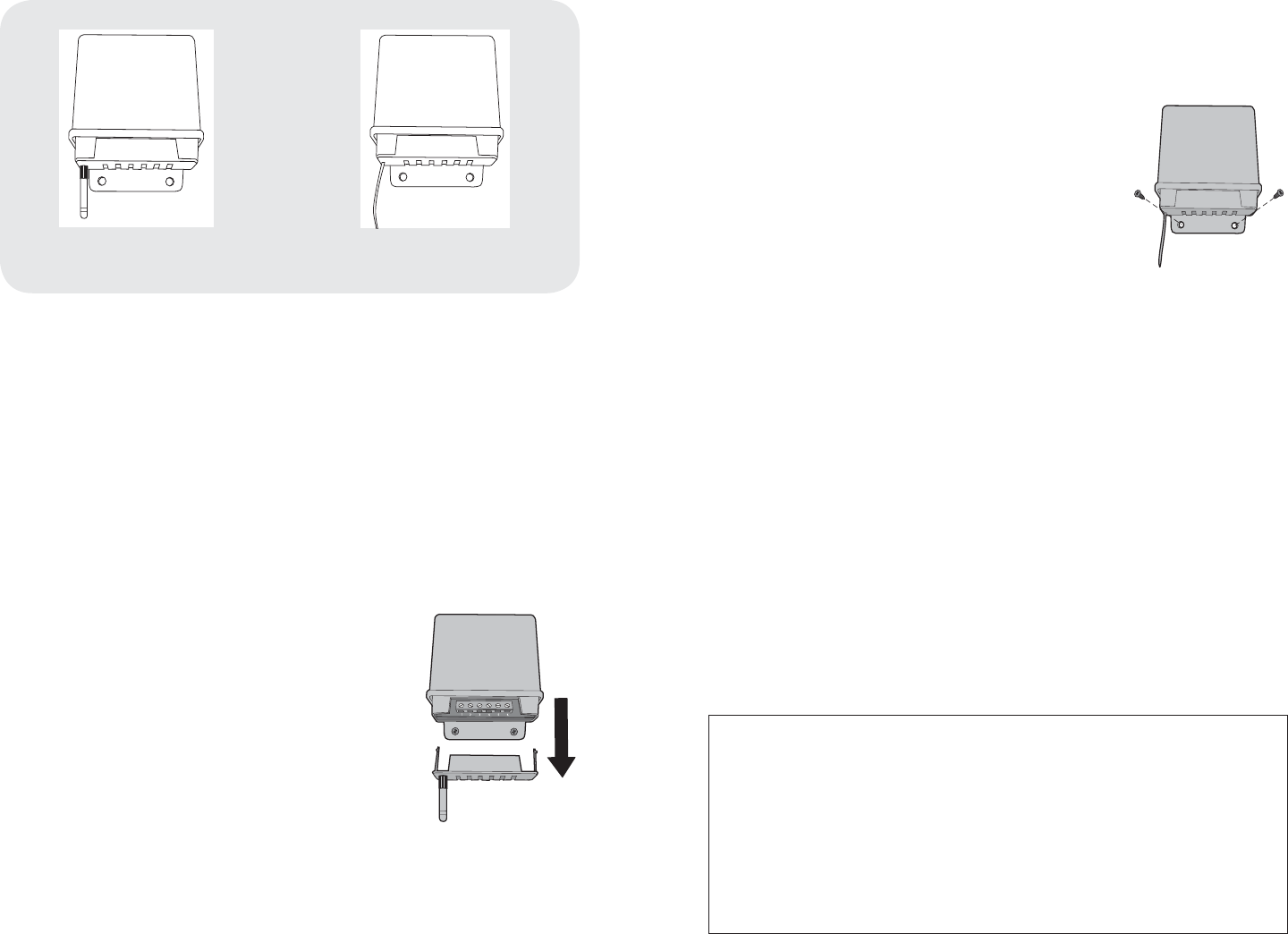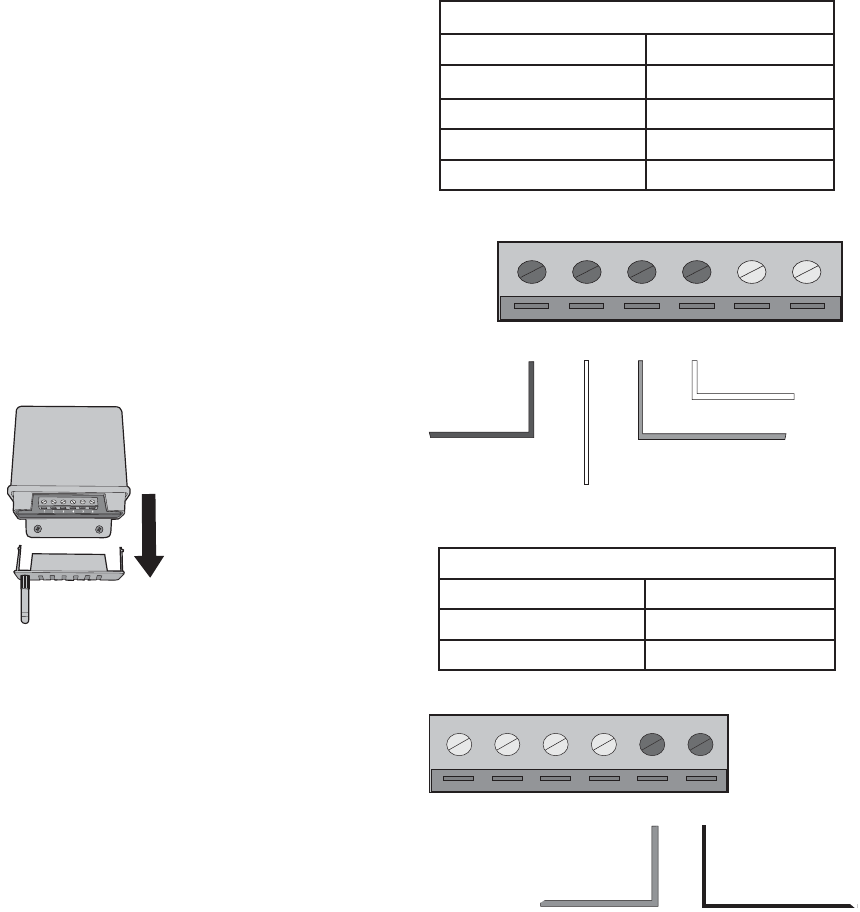Chamberlain Group The XCVR1 Remote Control Transceiver User Manual 114A3884 T1000 R1000 indd
Chamberlain Group Inc, The Remote Control Transceiver 114A3884 T1000 R1000 indd
Exhibit D Users Manual per 2 1033 b3

6
For Technical Support Please Call:
1-888-528-7826
www.chamberlainaccess.com
© Chamberlain Access Solutions
All Rights Reserved
Troubleshooting
Repeater service alerts are managed in the overlock management software.
In the software, go to Tools\Manage Repeaters to view and clear alerts.
Low Battery Indication
The battery power on the R1000 repeater is supervised by the Overlock
Management Software. A low battery indication will generate an alert in
the software, notifying the administrator.
114A3884
ACCESSMASTER T1000 TRANSCEIVER
AND
ACCESSMASTER R1000 REPEATER
INSTALLATION MANUAL

T1000 Overview
The T1000 transceiver is designed to allow communication between
the AccessMaster Overlock and the Falcon XT access control system.
The T1000 transceiver provides a secure, reliable wireless mode of
communication without the need to run excess wiring throughout the site.
The T1000 is designed to work only with the R1000 repeater and/or the
OL1000 overlock device.
Wiring the Transceiver
Remove the bottom panel of the T1000 transceiver to view the power and
communication pins.
Power and Communication from the XT to the
Transceiver
Power from the XT to the transceiver is provided
via RS422 (18 AWG, single-pair, stranded,
tinned copper) using 12 VDC. The power wire is
connected to pins 5 and 6 on the transceiver port.
Connect the positive 12 VDC to pin 5 and ground
to pin 6.
Wire for communications must be 24 AWG, 2-pair,
stranded, tinned copper, individual shield, drain
wire, low capacitance wire.
Communication connections on the transceiver are made on pins 1, 2, 3,
and 4. Communication to the XT occurs on pin 1 (TX+) and pin 2 (TX-).
Communication from the XT occurs on pin 3 (RX-) and pin 4 (RX+).
Wiring connections are shown on page 2.
ACCESSMASTER T1000
Transceiver
(T1000)
or
Antenna
Screws
Repeater (R1000)
AC/DC Power Supply
Screws
Carton Inventory
5
Mounting the R1000
Prior to mounting the repeater, write down the serial number of the device.
This number will be needed during programming. Use the following
guidelines when mounting the repeater.
Mount the unit within 50 ft of a power source
•
Mount the unit in an area protected from the
•
weather
Mount the unit as high as possible on the site
•
(such as near the roof ine) using the provided
mounting screws
Mount the unit to a solid, nonmetal surface
•
The unit should be halfway between the
•
devices that need to communicate.
The unit is weather-resistant
•
Warning: Do not try to add length to the antenna to extend the repeater’s range
as this will cause the system to become inoperational and/or will exceed FCC
requirements.
Installing Multiple Repeaters
On large sites, multiple repeaters may be required to provide adequate
communication coverage. Up to 8 repeaters can be learned to one
transceiver, with up to 64 repeaters to one site.
R1000 Operation
The R1000 repeater extends the range of the T1000 transceiver to cover
larger areas. Repeaters should be located throughout the site in such a
way
that coverage overlaps slightly to provide the most complete coverage. Up
to 8 repeaters can be programmed to communicate with one transceiver.
NOTICE: To comply with FCC and or Industry Canada rules (IC), adjustment
or modifications of this receiver and/or transmitter are prohibited, except for
changing the code setting or replacing the battery. THERE ARE NO OTHER
USER SERVICEABLE PARTS.
This device complies with part 15 of the FCC rules. Operation is subject to the
following two conditions: (1) This device may not cause harmful interference,
and (2) This device must accept any interference received including interference
that may cause undesired operations.
FCC ID: HBWGCU2 IC:2666A-GCU2

4
R1000 Overview
The R1000 repeater can be added to the T1000 system to extend the
range of the T1000 transceiver up to 500 ft, depending on the conditions
of the site. The R1000 repeater provides a secure, reliable wireless mode
of communication without the need to run excess wiring throughout the
site. The R1000 is designed to work only with the T1000 transceiver and
the OL1000 overlock device.
R1000 Assembly
Remove cover.1.
Insert 4 lithium batteries 2.
Replace the cover3.
Wiring the Repeater
The repeater must be connected to an AC/DC power supply. Remove the
bottom panel of the repeater to view the power pins.
For AC power:
Connect the red and black wires to terminals 1 and
2. (With AC power, it doesn’t matter whether the red
or black is connected to the + terminal, however, wire
color use should be consistent throughout the site)
For DC power:
Connect the red wire to terminal 1 (DC+)
Connect the black wire to terminal 3 (DC-)
Set Up the R1000
To program the repeater, the device must ‘learn’ the devices to communicate
with. Devices must be manually learned before installation. To manually
learn repeaters to the transceiver:
After the transceiver is connected to the Falcon XT, press the 1.
function button on the transceiver (SW1) to put it in learn mode.
When the red LED is lit (not blinking) the transceiver is in learn mode.
Press the Learn button on the repeater to be learned. The LED on 2.
both the repeter and the transceiver will pulse while the device is
being learned. When the LED on the repeater goes out, the device
is learned. Learn all repeaters in this manner.
After all repeaters have been learned to the transceiver, press 3.
the function button on the tranceiver and the LED will go off. The
transceiver is no longer in learn mode.
ACCESSMASTER R1000
1
Communication Connections
Pin Comm
1 TX +
2 TX -
3 RX -
4 RX +
12 VDC 100 mA
Pin Power
5 12 VDC
6 Ground
NOTE: Auxiliary power for peripheral devices is NOT provided on the transceiver . These
devices must be powered separately.
132456
RX-
RX+
TX-
TX+
Ground
+-
132456
12 VDC

2
Power and Communication from the Transceiver to the XT
Power from the controller to the transceiver is provided via RS422 (18
AWG, single-pair, stranded, tinned copper) using 12 VDC. The power
wire is connected to pins 5 and 6 on the transceiver port. Connect the
positive 12 VDC to pin 5 and ground to pin 6.
Wire for communications must be 24 AWG, 2-pair, stranded, tinned copper,
individual shield, drain wire, low capacitance wire.
Communication connections on the transceiver are made on pins 1, 2, 3,
and 4. Communication to the XT occurs on pin 1 (TX+) and pin 2 (TX-).
Communication from the XT occurs on pin 3 (RX-) and pin 4 (RX+). Wiring
connections are shown on page 2.
Set Up the T1000
After wiring is completed, push the learn button once to verify power .
The LED will light if power is connected correctly . The LED will go of f
automatically after a few seconds. This will also automatically learn the
transceiver to the Falcon XT.
Mounting the Transceiver
Prior to mounting the transceiver , write down the serial number of the
device. This number will be needed during programming. Use the following
guidelines when mounting the transceiver.
Mount the unit in an area protected from the weather•
Mount the unit as high as possible on the site (such as near •
the roof ine) using the provided mounting screws or appropriate
mounting hardware for the application
Mount the unit to a solid, nonmetal surface •
The unit is weather-resistant•
Warning: Do not try to add length to the antenna to
extend the transceiver’s range as this will cause the
system to become inoperational and/or will exceed
FCC requirements.
3
Installing Multiple Transceivers
On large sites, multiple transceivers may be required to provide adequate
communication coverage. Up to 8 transceivers can be installed on one site
and learned to one Falcon XT, with up to 1024 overlocks per transceiver
(allowing a maximum of 8192 overlocks per site).
While 24 AWG wire is the minimum recommended, the wire gauge may
need to be increased depending on the length of wire to be run and
the number of transceivers to be used. The wire used must ensure that
adequate voltage is available at the last device in-line. The minimum
allowable voltage at the device furthest from the Falcon XT is 7.5V.
NOTE: Ensure that the wire run does not reduce the voltage to less than 7.5 V at
the device furthest from the Falcon XT.
T1000 Operation
The transceiver is a bi-directional transmitter that facilitates communication
between the Falcon XT access control system and overlock devices used to
control individual doors. Communication occurs over multiple RF
channels concurrently to ensure constant communication capability.When
the transceiver receives input from the XT,it sends the signal to the
overlock device to control the overlock function. The transceiver continually
scans for a signal from the overlock and if a determined period of time
elapses with no signal, the transceiver sends an alert, which shows up on
the main screen of the overlock management software.
TThe The thethe transceiver receives input from the XT, it sends
that signal
to the overlock device to control the overlock function. The transceiver
continually scans for a signal from the overlock and if a determined period of
time elapses with no signal, the transceiver sends an alert, which shows up
on the main screen of the overlock management software.
Troubleshooting
Transceiver service alerts are managed in the overlock management
software. In the software, go to Tools\Manage Transceivers to view and
clear alerts.
NOTICE: To comply with FCC and or Industry Canada rules (IC), adjustment or
modifications of this receiver and/or transmitter are prohibited, except for changing
the code setting or replacing the battery. THERE ARE NO OTHER USER
SERVICEABLE PARTS. This device complies with part 15 of the FCC rules.
Operation is subject to the following two conditions: (1) This device may not cause
harmful interference, and (2) This device must accept any interference received
including interference that may cause undesired operations.
FCC ID: HBWXCVR1 IC:2666A-XCVR1